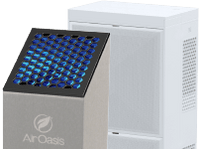Pollution in the Air: A Guide to Smog
The human population has a huge impact on the Earth and its resources. One pollutant mainly caused by humans is smog. While the term was originally used to describe a combination of fog and smoke, today it generally refers to a mixture of pollution in the air that is made up primarily of ground level ozone. Depending on its location, ozone can be either harmful or beneficial. The beneficial ozone is that which is located in the Earth’s stratosphere and it helps to protect the environment as well as human health. Ground level ozone is harmful and can cause stinging eyes, coughing, choking, and other health-related issues.
What is Smog Made Of?
Smog is normally produced through a set of complex photochemical reactions involving nitrogen oxides, and volatile organic compounds, which in the presence of sunlight, result in ozone being produced. The pollutants that cause smog to form can come from many sources including power plants, vehicle exhausts, factories, and countless consumer products. In urban areas, at least half of smog-causing pollutants come from buses, cars, boats, and trucks.
The occurrence of smog is often linked to high temperatures, traffic, calm winds, and sun. The severity of smog is affected by geography and weather. Due to the fact that temperature regulates the amount of time it takes for smog to form, it can be more severe and form faster on hotter, sunnier days. Warm temperatures combined with calm winds can cause smog to become trapped over an area for several days. Problems with severe smog exist in many big cities in the United States and elsewhere around the world.
The Effects of Smog
Smog is a mixture of air pollutants that can harm the environment, negatively affect health, and even cause damage to property. Health issues associated with smog include trouble breathing, eye irritation, asthma, and more. Environmentally, smog inhibits the growth of plants and can cause major damage to forests and crops.
How Smog is Measured
Smog is an example of air pollution that is visible to the naked eye. In addition to being able to look at the horizon and see smog, many cities measure air pollutants and make the results available to the public. There are standardized measures that have been created, such as the air quality index, also called the pollution standards index. The air quality index allows for the comparison of pollution levels in different cities.
The Clean Air Act
In 1990, the Clean Air Act was established as a way to reduce widespread pollution including nitrogen oxides, ozone, and particulates in smog. The Environmental Protection Agency (EPA) established a set of national standards for certain pollutants with states being required to take action to ensure standards are met. Cities that fail to maintain standards are required to take steps to clean up based on a set of realistic goals and guidelines. Cities that need to take steps to adhere to standards may do things such as use alternative fuel, change gas composition, and impose restrictions on residents. Such restrictions may include the banning of wood burning stoves and charcoal barbecues. Programs have also been developed which encourage voluntary actions such as carpooling. In really congested areas, traffic may need to be restricted and public transportation improved to help prevent smog.
Learn More About Smog
To learn more about smog, visit the following pages
- Smog: Who Does it Hurt?
- International Study: Where There’s Smoke or Smog, There’s Climate Change
- Auto Emissions and Air Pollution
- What Are the Health Effects of Air Pollution?
- US Air Quality - The Smog Blog
- Photochemical Smog Reactions
- The Health Effects of Air Pollution
- Photochemical Smog Formation
- Acid Rain and the Smog
